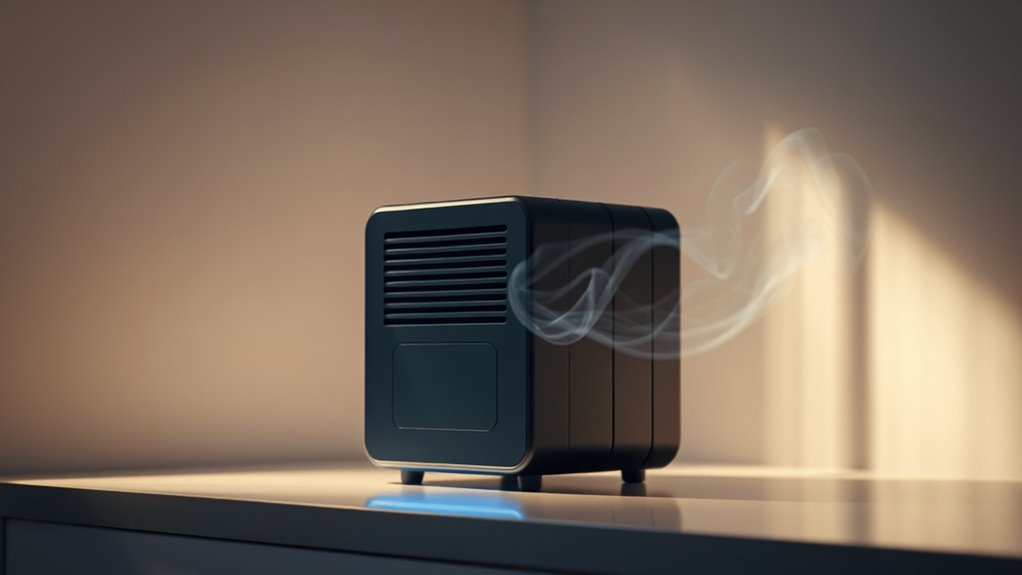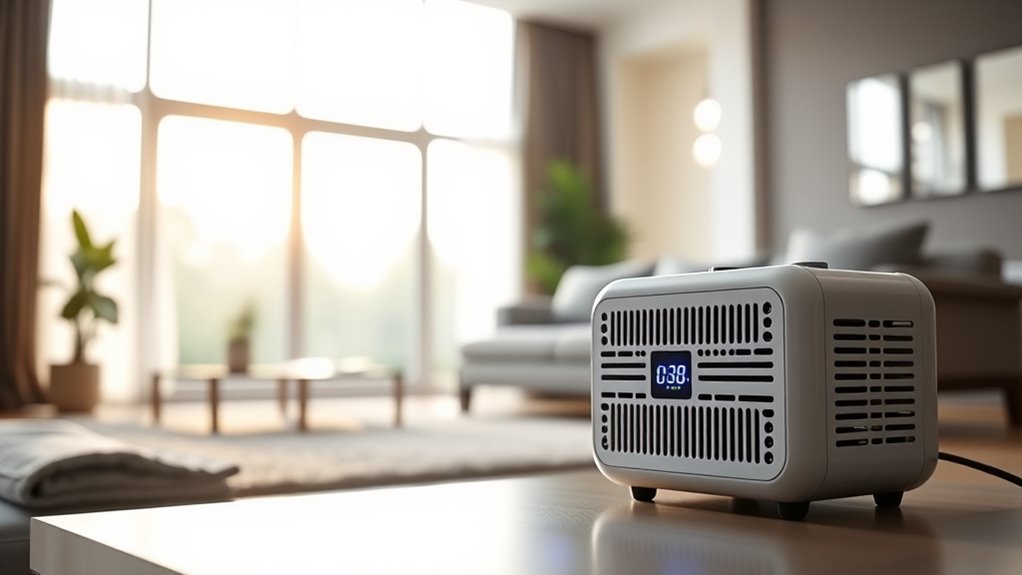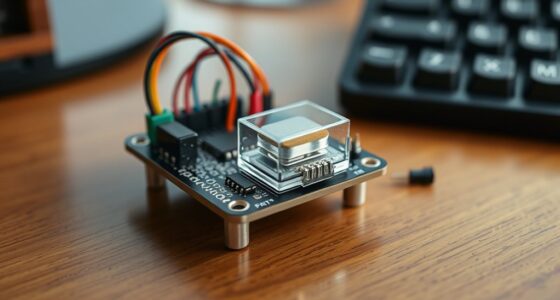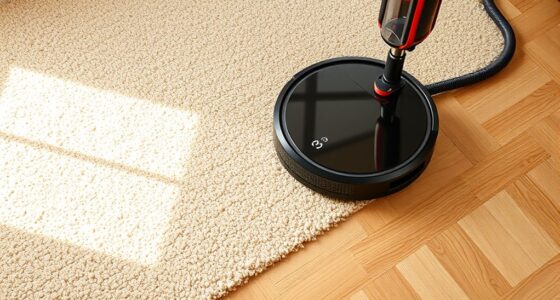Ozone generators may seem like a quick fix for stubborn odors, but they actually pose serious health risks. They produce ozone, which can irritate your lungs, throat, and chest, especially in occupied spaces. While some claim they kill bacteria or neutralize smells, scientific evidence shows their effectiveness is limited and inconsistent. Safer alternatives like ventilation and activated charcoal work better without risking your health. If you keep exploring, you’ll see why these devices are more fad than fix.
Key Takeaways
- Ozone generators can temporarily eliminate some odors but pose significant health risks due to respiratory irritation.
- Scientific evidence suggests limited effectiveness in odor removal and microbial deactivation.
- Health organizations warn against using ozone devices in occupied spaces because of potential lung harm.
- Safer alternatives like ventilation and activated charcoal are more reliable for odor control.
- Regulatory challenges and safety concerns make ozone generators more of a risky fad than a miracle solution.

Have you ever wondered how ozone generators can effectively eliminate odors and purify the air? These devices are often marketed as powerful tools to clear out cigarette smoke, pet odors, mold, and other airborne pollutants. But before you invest in one, it’s important to understand the health concerns surrounding their use and the effectiveness debates that surround them. Ozone generators produce ozone, a molecule composed of three oxygen atoms, which is known for its strong oxidizing properties. While ozone can react with certain odor-causing compounds, it’s not a one-size-fits-all solution. Many experts question whether the advantages outweigh the potential risks.
One major concern is health. Ozone is a respiratory irritant that can cause chest pain, coughing, throat irritation, and shortness of breath, especially in sensitive groups like children, the elderly, or those with asthma or other lung conditions. When you run an ozone generator in an enclosed space, you risk exposing yourself and others to dangerous levels of ozone. Even after the device is turned off, residual ozone can linger, continuing to pose health risks. Because of these hazards, health organizations such as the EPA warn against using ozone generators in occupied spaces. Instead, they recommend safer, traditional air purification methods like HEPA filters, which trap pollutants without producing harmful byproducts. Additionally, the regulatory challenges surrounding ozone use make it difficult to establish safe, consistent standards for consumer devices.
The effectiveness debates further complicate the picture. While some claim ozone generators are highly effective at removing odors and killing bacteria or mold spores, scientific studies paint a more nuanced picture. Ozone does have the ability to neutralize some odor molecules and deactivate certain bacteria, but it doesn’t eliminate all airborne contaminants or replace proper cleaning. Many experts argue that the ozone concentrations produced by typical consumer devices are often too low to make a meaningful difference. Conversely, overuse or high settings can create unsafe levels of ozone, making the device more harmful than helpful. This has led to ongoing debates about whether ozone generators are truly effective or just risky gimmicks.
In the end, it’s wise to approach ozone generators with caution. While they may seem like a quick fix for bad odors, the potential health risks outweigh the benefits if not used properly. Instead, consider safer alternatives for air purification and odor removal, such as improving ventilation, using activated charcoal, or investing in proven air cleaning technologies. Your health and air quality are worth the extra effort to choose safer, more effective methods.
Frequently Asked Questions
Are Ozone Generators Safe for Use Around Children and Pets?
You should know that ozone generators are not safe for use around children and pets due to health concerns. Ozone can irritate their lungs and worsen respiratory issues. To guarantee safety, follow strict safety guidelines, like avoiding use when people or animals are present and ventilating the area afterward. Always prioritize their health, and consider alternative odor removal methods that don’t pose risks to your loved ones.
How Long Does It Take for Ozone to Eliminate Odors Effectively?
Imagine a gust of wind sweeping through a smelly room, clearing out the haze—that’s how quickly ozone begins its odor neutralization work. Typically, it takes about 30 minutes to a few hours for ozone to effectively purify the air and eliminate stubborn odors. During this time, ozone actively breaks down odor molecules, making your space smell fresh again through efficient air purification.
Can Ozone Generators Remove All Types of Indoor Pollutants?
Ozone generators can help with air purification and odor elimination, but they don’t remove all types of indoor pollutants. You might see improvements in odors caused by smoke or pets, but they aren’t effective against dust, chemicals, or biological contaminants. Plus, using ozone improperly can be dangerous. So, while they can assist with certain odors, you should consider other air purification methods for all-encompassing indoor air quality.
What Are the Long-Term Health Risks of Ozone Exposure?
You should know that long-term ozone exposure poses significant respiratory hazards. Chronic exposure can worsen asthma, cause lung inflammation, and reduce lung function over time. Even if it temporarily improves odors, you risk serious health problems with ongoing use. It’s better to avoid prolonged ozone contact, especially if you have respiratory issues, since the dangers of chronic exposure outweigh any short-term benefits.
Are There Legal Restrictions on Using Ozone Generators in Residential Areas?
You should know that using ozone generators in residential areas is often restricted by legal regulations due to health concerns. Many regions enforce regulatory compliance by banning or limiting their use indoors, especially when people are present. Always check local laws and manufacturer instructions before operating an ozone generator. Ignoring legal restrictions can lead to fines or health risks, so stay informed to guarantee safe and legal use of these devices.
Conclusion
So, before you rush to buy that ozone generator, ask yourself: are you chasing a miracle or risking a nightmare? While it may seem like a quick fix, the potential dangers linger like shadows in the dark. Don’t let the promise of fresh air blind you to the hidden risks. Remember, sometimes the brightest lights cast the deepest shadows—choose wisely, and breathe safely.









